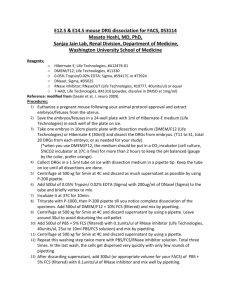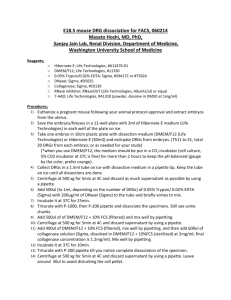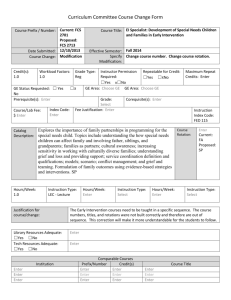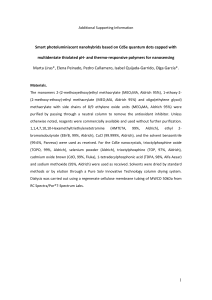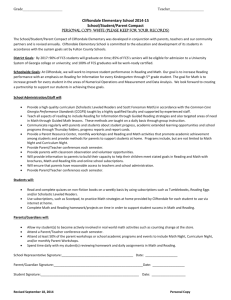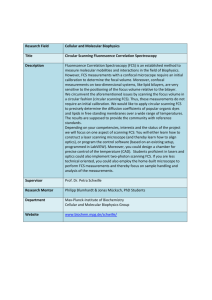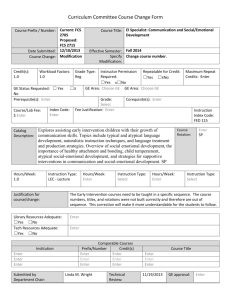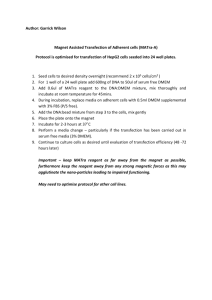SUPPLEMENTAL MATERIAL Expanded Methods Plasma
advertisement
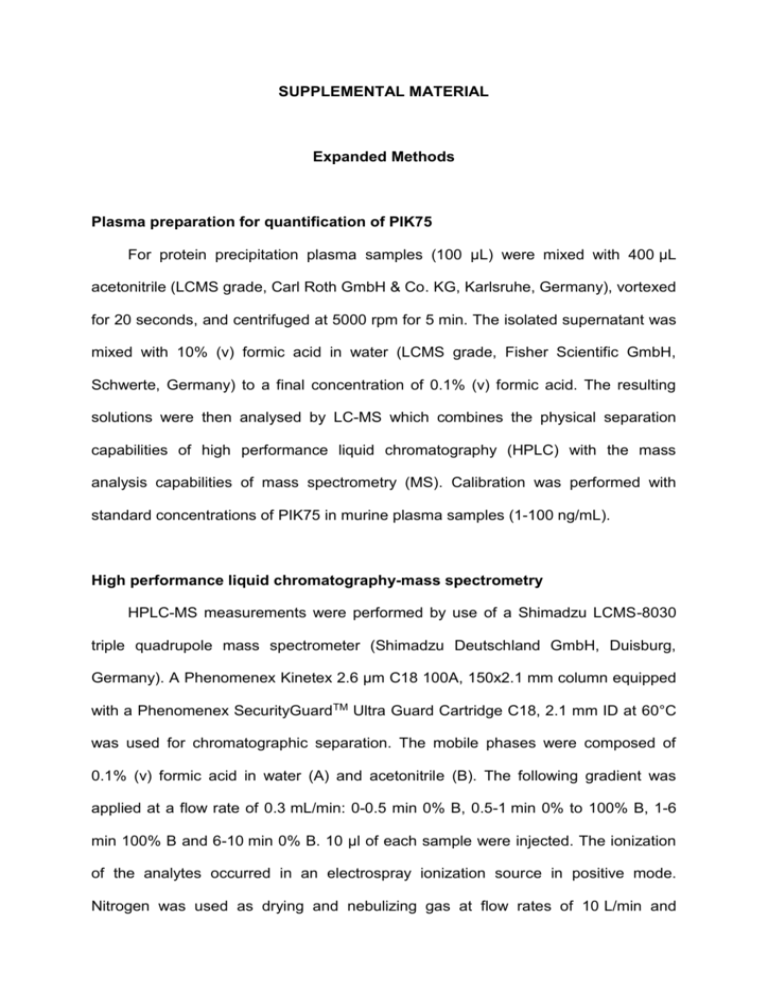
SUPPLEMENTAL MATERIAL Expanded Methods Plasma preparation for quantification of PIK75 For protein precipitation plasma samples (100 µL) were mixed with 400 µL acetonitrile (LCMS grade, Carl Roth GmbH & Co. KG, Karlsruhe, Germany), vortexed for 20 seconds, and centrifuged at 5000 rpm for 5 min. The isolated supernatant was mixed with 10% (v) formic acid in water (LCMS grade, Fisher Scientific GmbH, Schwerte, Germany) to a final concentration of 0.1% (v) formic acid. The resulting solutions were then analysed by LC-MS which combines the physical separation capabilities of high performance liquid chromatography (HPLC) with the mass analysis capabilities of mass spectrometry (MS). Calibration was performed with standard concentrations of PIK75 in murine plasma samples (1-100 ng/mL). High performance liquid chromatography-mass spectrometry HPLC-MS measurements were performed by use of a Shimadzu LCMS-8030 triple quadrupole mass spectrometer (Shimadzu Deutschland GmbH, Duisburg, Germany). A Phenomenex Kinetex 2.6 µm C18 100A, 150x2.1 mm column equipped with a Phenomenex SecurityGuardTM Ultra Guard Cartridge C18, 2.1 mm ID at 60°C was used for chromatographic separation. The mobile phases were composed of 0.1% (v) formic acid in water (A) and acetonitrile (B). The following gradient was applied at a flow rate of 0.3 mL/min: 0-0.5 min 0% B, 0.5-1 min 0% to 100% B, 1-6 min 100% B and 6-10 min 0% B. 10 µl of each sample were injected. The ionization of the analytes occurred in an electrospray ionization source in positive mode. Nitrogen was used as drying and nebulizing gas at flow rates of 10 L/min and 2 L/min, respectively. The desolvation line temperature was set to 125°C and the heat block temperature was set to 200°C. For quantification of PIK75 multiple reaction monitoring transition m/z 451.8>252.0 was recorded and used for quantification. All samples were measured in triplicates. Prothrombin time (PT) and activated partial thromboplastin time (aPTT) Plasma was isolated from citrated murine blood (3.2%; 1/10) by centrifugation (2500 g; 4°C; 15 minutes). PT and aPTT were assessed using the START 4 analyzer (Diagnostica Stago, France) according to the manufacturers instructions. Tail bleeding times Analysis of tail bleeding times was performed as described6. Briefly, 24 hours after the last injection mice of each group were anesthetized and the distal 4 mm segment of the tail was removed with a scalpel. The tail was immersed in saline (37°C) in a hand-held tube. Gentle rotation of the tube was performed to prevent the shed blood from obscuring the incision site. Bleeding time was recorded as the time at which bleeding stopped. Platelet aggregation studies For studies performed in murine platelets, citrated blood (3.2%; 1/10) was drawn by puncture from the right ventricle. Aggregation studies were performed with citrated blood within 1 hour. Platelets were equilibrated under constant stirring for 1 minute prior addition of ADP (10 μM; Sigma Aldrich) or equine collagen type 1 (5 μg/mL; Chrono-Log). Aggregation was displayed as a function of time (AGGRO/LINK® Software; Chrono-Log). Results were monitored for 6 minutes and expressed as maximal aggregation (ohm[Ω]). siRNA knockdown experiments HAEC or AoSMC were plated on 6-well dishes 24 hours before transfection at a density of 20’000 and 15’000 cells, respectively. Four siRNA oligonucleotide sequences (Microsynth, Balgach, Switzerland) reported to target the human p110α catalytic subunit were used in combination at a concentration of 25 nM: 1015931 (sense sequence: 5’-GCUAUCAUCUGAACAAUUAUU-3’), 1015933 (sense sequence: 5’-GGAUAGAGGCCAAAUAAUAUU-3’), 1015935 (sense sequence: 5’GGACAACUGUUUCAUAUAGUU-3’), and 1015937 (sense sequence: 5’- GCCAGUACCUCAUGGAUUAUU-3’). Scrambled siRNA (Microsynth; 1050124; 5’GAUCAUACGUGCGAUCAGATT-3’) was used as control. Transfection was performed using the lipofectamine RNAi Max system (Sigma Aldrich). After transfection, cells were transferred to their corresponding growth medium and trypsinized for counting after 72 hours. Knockdown of p110α was confirmed at the protein level by Western blot analysis. Immunoblotting was performed using a human anti-p110α antibody at a dilution of 1:5000 (Cell Signalling Technology, Danvers, MA, USA). Rho A activity Rho A activity was determined by a pull-down assay. Cell lysates were incubated with Rhotekin Rho Binding Domain (Upstate Biotechnology, Lake Placid, NY) for 45 minutes according to the manufacturer’s instructions. The agarose beads were collected and electrophoresed in 12% SDS-PAGE gel. Western blotting was performed with RhoA antibody (1:1000, Upstate Biotechnology). RNA expression RNA was extracted from human cells and mouse aorta using TRIzol Reagent (Invitrogen, Carlsbad, CA) and reverse transcribed using Ready-To-Go You-Prime First-Strand Beads (Amersham, Buckinghamshire, UK). For real-time PCR analysis the following primers were used: for full length human TF (F3): sense 5’TCCCCAGAGTTCACACCTTACC–3’, TACAC–3’; for human PAI-1: antisense sense 5’–CCTTTCTCCTGGCCCA- 5’-GGGCCATGGAACAAGGATGA–3’; antisense: 5’-CTCCTTTCCCAAGCAAGTTG–3; for human ribosomal L28: sense 5’GCATCTGCAATGGATGGT-3’, antisense 5′-TGTTCTTGCGGATCATGTGT-3′; for murine full length tissue factor: sense: 5'-CAATGAATTCTCGATTGATGTGG-3', antisense: 5'-GGAGGATGATAAAGATGGTGGC-3'; for murine tissue factor pathway inhibitor: sense: 5'-ACTGTGTGTCTGTTGCTTAGCC-3', GTTCTCGTTCCCTTCACATCCC-3'; for ATGCTGTGTCTGACTTAGCCAG-3; PAI-1: 5'- sense: 5'- antisense: GCTGTGTGTCTGAAGCTTAGCC-3’; GCTAGAGTGTCTGAAGCTTATG-3’; murine antisense: for murine antisense: 5't-PA: sense: 5'5'- ATAATGTGTTCTGACTTAGCCAG-3; and for murine ribosomal S12: sense: 5'GAAGCTGCCAAAGCCTTAGA-3', antisense: 5'-AACTGCAACCAACCACCTTC-3'. The amplification program consisted of 1 cycle at 95°C for 10 minutes followed by 35 cycles with a denaturing phase at 95°C for 30 seconds, an annealing phase at 60°C for 1 minute, and an elongation phase at 72°C for 1 minute. Real-time PCR amplification was performed in an MX3000P PCR cycler (Stratagene) using the SYBR Green JumpStart kit (Sigma Aldrich, St. Louis, MO, USA) in 25 μL final reaction volume containing 2 μL cDNA, 10 pmol of each primer, 0.25 μL of internal reference dye, and 12.5 μL of JumpStart Taq ReadyMix (buffer, dNTP, stabilizers, SYBR Green, Taq polymerase, and JumpStart Taq antibody). Melting curve analysis confirmed the accuracy of the amplicon, and PCR products were analyzed on an ethidium bromide stained 1% agarose gel. TF and PAI-1 activity To assess TF activity, factor Xa generation was analyzed using the Achtichrome colorimetric assay (American Diagnostica Inc.). TF/FVIIa complex converted recombinant factor X to factor Xa, which was measured by its ability to metabolize a chromogenic substrate. The absorbance of the reaction mixture was measured at 405 nm and values displayed after subtraction of the background value. For analysis of factor Xa generation in mouse carotid arteries, the uninjured left carotid arteries from treated and control mice were homogenized in 50 μL lysis buffer (0.1% Triton-X, 100 mmol NaCl, 50 mmol Tris-HCl, pH 7.4). 25 μg of tissue lysates were used for measurements. PAI-1 activity in tissue lysates was determined using the SPECTROLYSE colorimetric assay (American Diagnostica Inc.). 30 μg of tissue lysates were incubated with t-PA and PAI-1 allowed to inhibit t-PA. Residual t-PA activity was measured by adding the sample to a mixture of human glu-plasminogen, poly-D-lysine and a chromogenic substrate for plasmin. The residual t-PA activity in the plasma sample catalyzes the conversion of plasminogen to plasmin, which in turn hydrolyzes the chromogenic substrate. Protein expression For analysis of eNOS expression, HAEC were serum starved with EBM-2 plus 0.5% FCS for 24 hours in the presence of PIK75 (10 nM), rapamycin (10 nM, Sigma Aldrich), paclitaxel (10 nM, Sigma Aldrich), or vehicle. For analysis of TF and PAI-1 expression, subconfluent HAEC were rendered quiescent for 24 hours and treated with PIK75 (10 nM), TGX221 (10 nM, Cayman Chemical), AS605240 (10 nM, Sigma Aldrich), IC87114 (10 nM, Symansis, Auckland, NZ), rapamycin (10 nM, Sigma Aldrich), paclitaxel (10 nM, Sigma Aldrich), or vehicle (0.1% dimethylsulfoxide) for 1 hour prior to stimulation with TNF-α (5 ng/ml; R&D Systems, Minneapolis, MN, USA) for 5 hours. For expression analysis in AoSMC, cells were starved for 24 hours followed by incubation with PIK75 for 24 hours. Protein expression was determined by Western blot analysis. Cells were lysed in 50 mMTris buffer. 35 µg samples were loaded and separated by 10% sodium dodecyl sulfate-polyacrylamide gel electrophoresis. Proteins were transferred to a polyvinylidene difluoride membrane by semidry transfer. Antibody to eNOS (BD Biosciences), TF (American Diagnostica), and PAI-1 (Santa Cruz Biotechnology Inc., Santa Cruz, CA, USA) were used at 1:2000, 1:2000, and 1:5000 dilution, respectively. All blots were normalized to glyceraldehyde-3-phosphate dehydrogenase (GAPDH) expression (1:5000 dilution, Chemicon International, Temecula, CA, USA). Protein quantification was performed by densitometric analysis using Scion Image Software (Scion Corp., Frederick, MD, USA). Nuclear extracts and NFkB activity For measurement of NFkB activity, AoSMC were treated with PIK75 (30 μM) or vehicle for 24 hours. Nuclear extracts were obtained from AoSMC using a nuclear extraction kit (Active Motif, Carlsbad, USA). Cells were harvested in hypotonic buffer for 15 min before centrifugation, isolated nuclei were resuspended in a hypertonic buffer, and nuclear protein was extracted by incubation on a rotator for 30 min. The supernatant containing the nuclear protein was collected after centrifugation. The DNA binding reaction was carried out with 5 μg of nuclear protein in a 96-well plate coated with consensus sequences for NFκB (GGGACTTTCC) for 1 h at room temperature. After washing, NFkB/p65 antibody (Active Motif) was added and incubated for 1 h, followed by incubation with a horseradish peroxidase-conjugated secondary antibody. Finally, NFkB/p65 DNA binding was assessed spectrophotometrically at 450 nm. Proliferation assay For cell counts AoSMC and SVSMC were seeded at a density of 15’000 cells per 35 mm dish and cultured in DMEM plus 10% FCS for 24 hours. After 48 hours of serum withdrawal (DMEM plus 0.2% bovine serum albumin) the cells were incubated with either the small molecule p110α-inhibitor PIK75, paclitaxel, rapamycin, or vehicle (0.1 % dimethylsulfoxide) in the presence of platelet derived growth factor-BB (PDGF-BB, 10 ng/ml) and the cells trypsinized and counted 72 hours later. HAEC and HUVEC were seeded at a density of 20’000 cells per 35 mm dish and grown in EGM-2 plus 10% FCS for 24 hours. Cells were rendered quiescient in endothelial basal medium-2 (EBM-2) plus 0.1% FCS for 24 hours, the drug and EGM-2 plus 10% FCS were added, and the cell number was assessed 72 hours later. Cell viability was assessed using a colorimetric assay for detection of lactate dehydrogenase release (Roche, Basel, Switzerland). Migration assay To assess migration in a 48-well modified Boyden chamber (Neuroprobe, Gaithersburg, MD, USA), AoSMC and SVSMC were seeded at a density of 70-80%, and kept in DMEM (containing 1 g/l glucose) plus 10% FCS for 36-48 hours. Cells were then trypsinized, washed with PBS, and resuspended in control medium (DMEM plus 0.1% BSA). For drug pretreatment, cell suspensions were incubated with the corresponding drug for 1 h at 37°C. 50 μl of cell suspension were loaded into the upper chamber, which was separated by a collagen-coated polycarbonate membrane (Neuro Probe, Inc. PFB8; 8 μm pores) from the lower chamber containing DMEM (supplemented with 0.1% BSA) plus the chemoattractant PDGF-BB (10 ng/ml). DMEM with PDGF-BB 10 ng/mL without the drug served as positive control, whereas DMEM alone was used as a negative control. Cells were allowed to migrate for 5 hours. Non-migrated cells were removed from the upper surface of the membrane with a cellscraper, and migrated cells on the bottom surface were fixed in ice-cold methanol for 10 minutes followed by staining with Diff-Quik (Medion Diagnostics, Dudingen, Switzerland). For migration assays, HAEC und HUVEC were processed the same way as AoSMC and SVSMC except that they were seeded and kept in EGM-2 plus 10% FCS and resuspended in EBM-2 plus 0.2% FCS as control medium. For all EC a 5 µm pore size collagen-coated polycarbonate membrane was used. EGM-2 plus 10% FCS alone represented the positive control, whereas EBM-2 supplemented with 0.1% BSA was used as negative control. Migration was assessed after 5 hours by counting cells in 4 random fields at 200x magnification using an Olympus BX51 microscope (Olympus Europa GmbH; Hamburg, Germany). Detection of nitric oxide production by electron spin resonance spectroscopy (ESR). Endothelial NO production was measured by ESR spectroscopy with the use of the spin-trap colloid Fe(DETC)2 as described previously2,3. Briefly, HAEC (150.000 per well) were cultured on 6 well plates for 24 hours in endothelial cell growth medium-2 and then incubated with PIK75, rapamycin or paclitaxel for 24 hours. Cells were washed twice with ice-cold Krebs-HEPES buffer (KHB). 900 µl of prewarmed (37°C) KHB and 300 μl of colloid Fe(DETC)2 (final concentration 285 μM) was then added to each sample and incubated at 37°C for 60 min. ESR spectra were recorded using a e-scan ESR spectrometer (Bruker). ESR instrumental settings were as follows: center-field 3434 G, sweep 80 G, microwave power 36.14 db, amplitude modulation 8.18 G, sweep time 5.24 s and number of scans 50. References 1. Broze GJ, Jr., Yin ZF, Lasky N. A tail vein bleeding time model and delayed bleeding in hemophiliac mice. Thromb Haemost. 2001;85:747-748. 2. Kleschyov AL, Mollnau H, Oelze M, Meinertz T, Huang Y, Harrison DG, Munzel T. Spin trapping of vascular nitric oxide using colloid Fe(II)diethyldithiocarbamate. Biochem Biophys Res Commun. 2000;275:672-677. 3. Sorrentino SA, Bahlmann FH, Besler C, Muller M, Schulz S, Kirchhoff N, Doerries C, Horvath T, Limbourg A, Limbourg F, Fliser D, Haller H, Drexler H, Landmesser U. Oxidant stress impairs in vivo reendothelialization capacity of endothelial progenitor cells from patients with type 2 diabetes mellitus: restoration by the peroxisome proliferator-activated receptor-gamma agonist rosiglitazone. Circulation. 2007;116:163-173. Supplemental Figure 1. PIK75 does not affect coagulation parameters Clotting assays demonstrate that PIK75 does not induce changes in prothrombin time (A), activated partial thromboplastin time (B) (n=7; p=0.47 and p=0.33 respectively). PIK75 treatment has no impact on platelet aggregation in response to ADP (C) or collagen (D) (n=7; p=0.07 and p=0.77 respectively). PIK75 does not affect TFPI (E) and t-PA (F) mRNA levels in carotid artery tissue lysates (n=8; p=0.52 and p=0.53 respectively). Supplemental Figure 2. PI3K/p110α promotes TF expression in PBMC In PBMC treatment with PIK75 resulted in a concentration-dependent decrease in TF expression (n=4; p*<0.05). Supplemental Figure 3. PI3K/p110α silencing with siRNA Treatment of HAEC (A) and AoSMC (B) with siRNA targeting p110α inhibits p110α protein expression (n=4; p<*0.01). Supplemental Figure 4. PI3K/p110α promotes SVSMC, but not HUVEC proliferation and chemotaxis Experiments performed in SVSMC (A and C) and HUVEC (B and D) confirmed the results obtained in arterial vascular smooth muscle and endothelial cells (n=5; p*<0.05).
